How to fish the Channel Pool on the Welsh Dee at Llangollen
Table of Contents
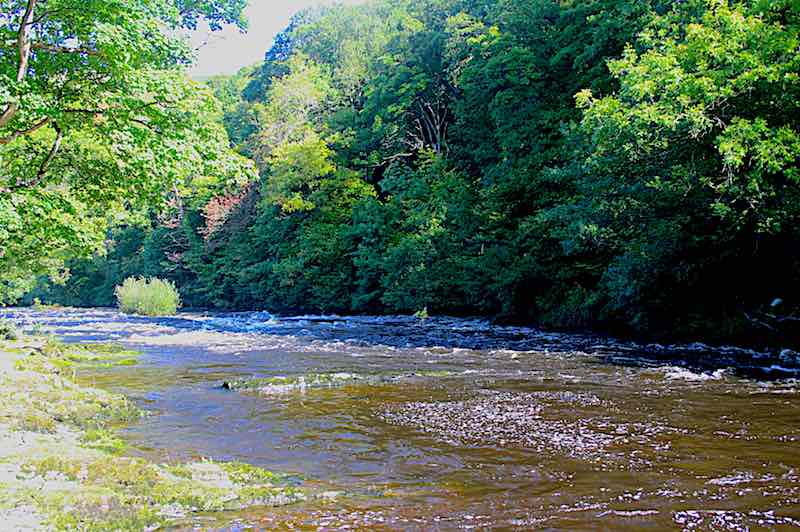
The Channel Pool Introduction
I’ve produced this fly fishing guide to share my knowledge on how to fish the Channel Pool, located on the Llangollen-Maelor’s middle beat of Welsh Dee.
This pool is a deep gully cut into the bedrock by the river over thousands of years and is a good resting place for salmon and sea trout when the river is low.
Unfortunately, it’s not easy to fish with the fly because of the strong flow through the narrow channel.
Over the years, some big salmon (20+lbs) have been caught in the Channel Pool using spinners and worms, but I have not heard of any falling to the fly.
The pool holds some big trout and graylings. I have caught a few large graylings in the fast water when the river is at its summer level (ca. 0.5m Corwen). Usually, large brown trout lie in the deep channel, but they are a challenge to catch.
Fly Fishing for trout & grayling:
The river flows south through the Channel pool but is shaded from the sun by the tree-lined left bank until lunchtime. The shade makes it a good place for fly fishing on bright, sunny days during the summer months.
The pool is accessible from both banks, but it is best to fish it from the open, right bank.
It’s best to fly fish the Channel Pool when the river is at its summer level because it flows too quickly to fish safely at higher levels.
In the following sketch of the Channel Pool, I’ve highlighted where I usually catch trout and grayling when the river is at its summer level.
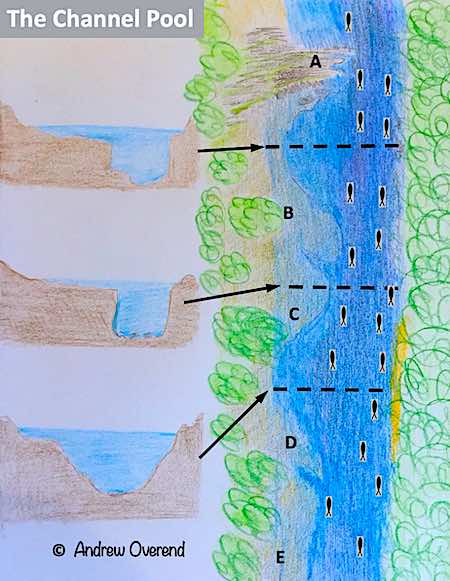
First of all, it’s not advisable to wade this pool because the riverbed is slippy and suddenly drops away into a deep channel. Also, there’s no need to wade when fishing this pool the dry fly.
On the right bank, a rock shelf extends into the middle of the river before it abruptly disappears into the deep channel.
During the day, trout and grayling are found in the deep channel and tucked into the shallower water on the left bank.
It is best to fish the head of the pool from the safety of the rock outcrop (point A). Take care when the rocks are wet because they’re very slippy.
There are several approaches to fishing the Channel Pool. However, it’s best to fish from the bank with the dry fly, starting at point (E) and fishing up to point (A).
Fly fishing the head of the pool (point A):
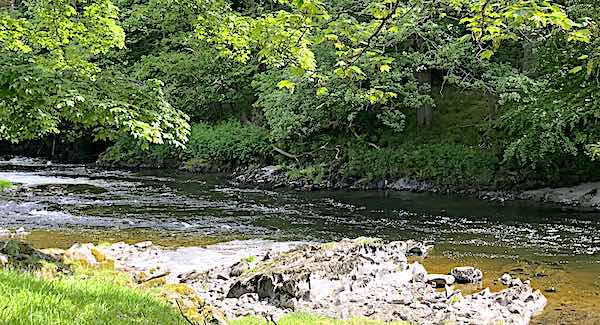
When the river is low during the summer, the head of the Channel Pool is a good place to fish because trout and grayling lie in the oxygenated water.
A good approach is to search the pockets of slacker water by fishing dry flies or nymphs suspended 3-4ft under a buoyant dry fly (Klink & Dink method).
Fish upriver from the rock outcrop while keeping as low a profile as possible to avoid spooking the fish.
Typically, you’ll only find a couple of fish holding in this zone, but they are often quality fish.
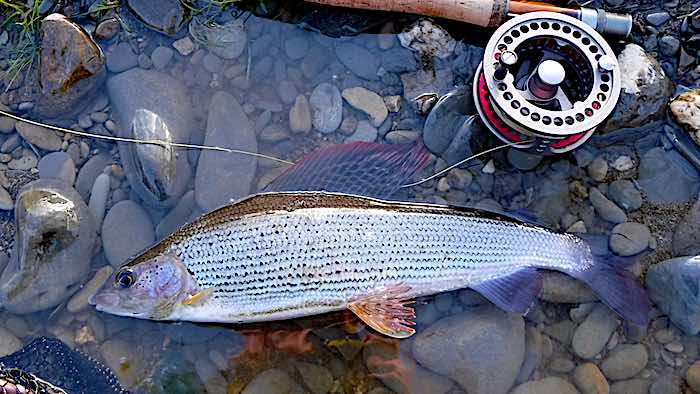
Fly fishing the zone (C) to (A):
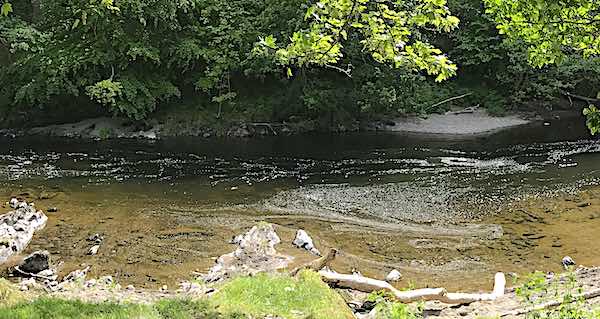
Trout tend to feed on flies in the foam lines in the zone from (C) to (A)
Initially, I avoid wading and from the bank, cover rising fish on the near-side of the main channel with the dry fly. Then, if safe to do so, I wade out onto the rock platform and cover the foam lines close to the far bank.
If the dry fly doesn’t catch anything, I rest this zone for 20 minutes while setting up a weighted nymph suspended 7ft under a sight fly.
Starting at point (C) I fish the main channel with the suspended nymph. This approach often picks out trout and grayling lying deep lying on close to the bottom of the channel.
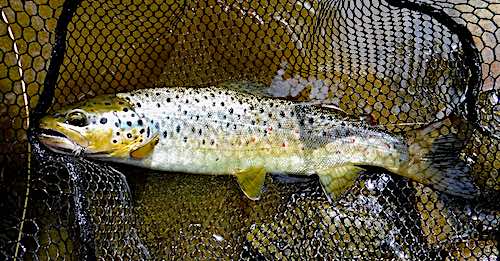
Fly fishing the zone (E) to (C):
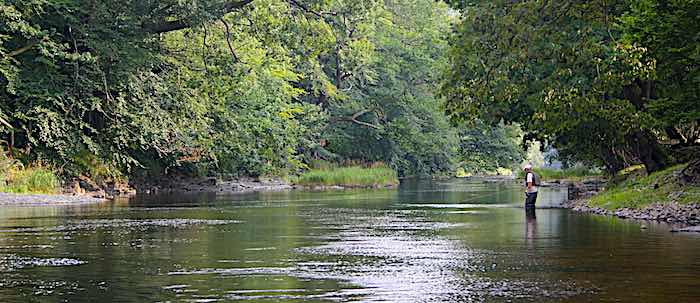
In the zone between (E) and (C), trout tend to rise from the start of the main channel to the far bank when the river is at its summer level.
Starting at the tail, usually, I fish upriver with the dry fly from the bank, covering the near-side of the main channel. Then, where possible, I will wade out onto the rock platform and cover the foam lines close to the far bank.
If the dry fly doesn’t catch anything, I rest this zone for 20 minutes while setting up to fish a weighted nymph suspended 7ft under a sight fly. After the break, I search the main channel from (E) to (C) with the Klink & Dink setup.
This approach picks any deep-lying trout and grayling.
In the evening, it is worth fishing down from (C) to (E) with a team of wet flies. Cast them across to the far bank and allow them to drift over the main channel.
In addition to trout and grayling, that method will occasionally catch sea trout between July and August.
How my approach changes with the season:
How to fish the Channel Pool in March:
The brown trout fishing season on the Welsh Dee starts on the 3rd of March. However, the weather in March is often more like winter than spring.
On mild days, hatches of large dark olives and March Browns usually start around 11 am, and you will often spot trout picking them off as they drift through this pool. During these hatches, I target the rising fish with the dry fly.
Alternatively, fly fishing with a team of wet flies on a floating line often yields some beautiful over-wintered brown trout. The following is one of my default teams of wet flies/spiders.
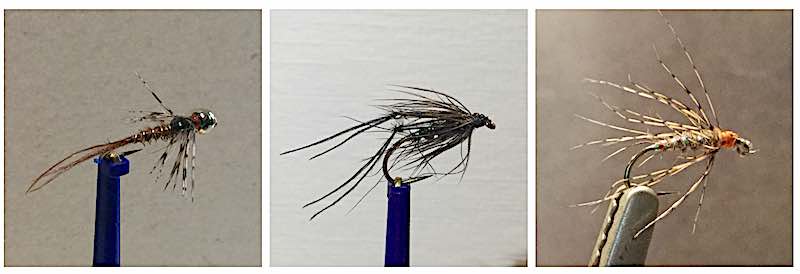
If either of the above fails, I will try my luck fishing the pool with a couple of nymphs suspended under a sight fly (Klink & Dink method).
For more information on the fly selection for March, check out the following article.
How to fish the Channel Pool in April:
Usually, the weather begins to warm in April and hatches of Large Dark Olives, March Brown, Grammon and other olives become prevalent from mid-morning to mid-afternoon. Thus, providing opportunities to catch brown trout on the dry fly.
The following post has information on the fly selection for April.
How to fish the Channel Pool in May:
As the weather warms and dries up during May, fly hatches become prolific and brown trout become eager to fatten up on the emerging fly life.
Examples of flies you will see include:
Upwinged flies:
- Blue winged olive
- Large dark olive
- Medium olive
- Iron Blue Dun
- Pale Watery Dun
- Olive Upright
- Yellow May Dun
Sedges:
- Black sedge
- Grannaom
- Cinnamon sedge
- Medium sedge
Others:
- Hawthorn fly
- Alderfly
- Large stone fly
- Midges
As a result of all the fly-life, May is when dry-fly and upstream wet-fly fishing produce the best catch results, when you have identified which flies the trout are taking.
On overcast days, the fishing can be good from morning to dusk.

On sunny days the fishing dies between 11 am and 5 pm because there is a lack of shade on this pool and the sun is behind you.
How to fish the Channel Pool from June to September:
A great place to fish in the summer when the river is low is the fast, oxygenated water at the head of the Channel pool. On sunny days, the best fishing is early in the morning and after 5 pm.
The following posts contain information on the fly selection during the summer months:
How to fish the Channel Pool in October:
My attention turns to grayling fly fishing from October to the end of February on the Welsh Dee.
During autumn and winter, river conditions often dominate my grayling fishing activities. As such, I only fish this pool if the river is running clear and the level is below 0.7m (Manley Hall gauge).
In October, fly hatches occur most days on the Welsh Dee. The flies you are likely to see hatching include:
- Iron Blue Dun
- Pale Watery Dun
- Egg laying Stoneflies
- Midges
The approach to fly fishing the Channel Pool depends on river height, water and weather conditions. In October, mornings are usually cold and fly hatches don’t start until mid-morning.
Before 10 am, I will start fishing the pool from the bank by casing a team of wet flies towards the far bank and allowing them to swing round to the dangle.
My default wet fly recommendation is the following team of three flies cast on 3lb copolymer (point: March Brown spider #14; middle dropper: black hopper #14; top dropper: claret spider #16).
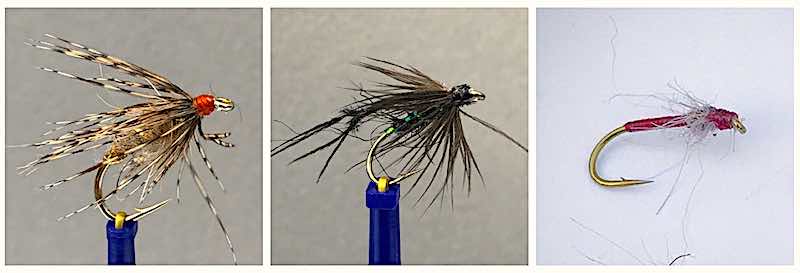
Once flies are observed hatching, I switch to targeting rising grayling with the dry fly. Ideally, it’s best to try and identify the flies that are being taken and tie on a good imitation.
If that is not possible, I usually start with a CDC olive emerger pattern that has served me well. If that doesn’t work, I start working through my fly box. However, it’s rare not to catch a grayling on one of the three following patterns:

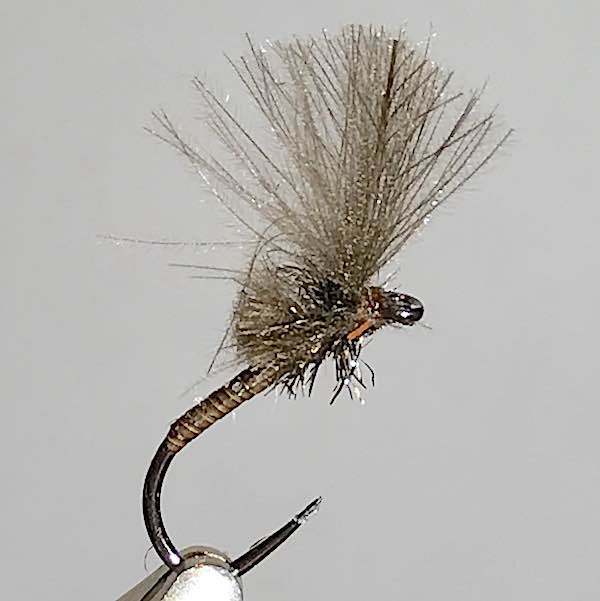

On rare occasions, it’s impossible to tempt grayling with either of the above approaches. Then it is necessary to switch to fishing nymphs close to the riverbed.
Check out the link below for additional reading on flies for October:
How to fish the Channel Pool in November:
The clocks go back at the end of October, and the days get increasingly shorter during November.
With aquatic life becoming dormant for winter, fly hatches are sparse, and grayling spend more time searching the riverbed for food: nymphs, larvae, worms, etc.
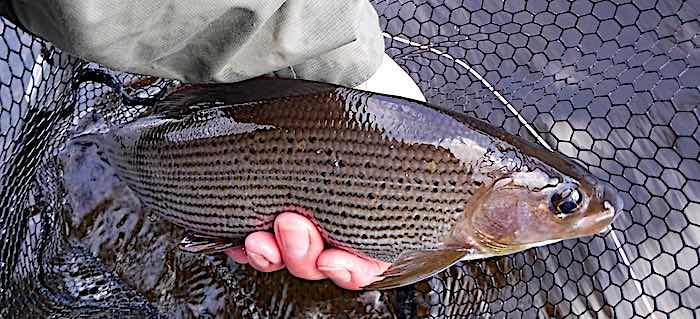
Fishing for grayling during November can be great sport because they have to feed hard to ensure they are in peak condition for spawning in spring.
On November mornings fishing a team of nymphs under a large dry fly or bung often yields good results.
Sporadic hatches of olives usually occur around lunchtime on mild days. If this happens, switching to fishing dry or wet flies often is often a good move.
For more information on the flies to use on the Welsh Dee during November check out the following article.
How to fish the Channel Pool December,January & February:
Once winter sets in, the Welsh Dee is often in flood during the winter months, and the opportunities to fish the Channel Pool diminish.
If the river level is below 0.7m (Manley Hall gauge), it is worth fishing for grayling because they start to shoal in the pool before spawning in the spring.
My approach to fishing this pool during the winter months is very similar to that used in November.
Check out the following articles for more information on the flies to use on the Welsh Dee in winter:
Fly fishing for sea trout:
In July, the pools near Llangollen become populated with sea trout and a few rest up in the Channel Pool during their journey upriver.
I rarely fish the Channel Pool for sea trout at night because the bank is too hazardous. However, I fish there for sea tout during the last couple of daylight using small wet flies.
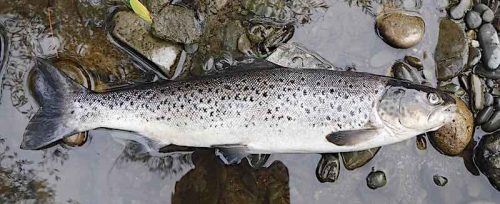
When you get a take, once you have set the hook, you just have to let the fish take off until you know what’s on the end of the line, since it’s just as likely to be a big grayling or brown trout than a sea trout.
The sea trout I’ve caught fishing the Channels Pool have not been large (i.e. 1 to 2lbs bracket) but they still are great sport.
Fly fishing for Salmon:
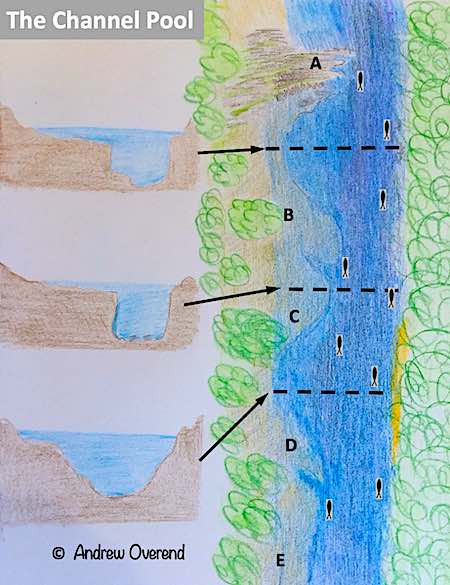
I’ve seen salmon jumping in the Channel Pool, but they’re difficult to catch on the fly. Most being caught on the worm and spinner.
To help you fish the Channel Pool for salmon, I have produced the following sketch show where they typically jump.
It is hard to fish all the pool with the salmon fly. From late August onward, when the river level is below 0.7m, I focus my fishing efforts between points A & B and C & D.
Either I use a floating line with a 12ft copolymer tapered leader (12lb tip) or a 10ft sink-tip line when the river is slightly coloured.
The lies between D and E are difficult to cover with the fly, and it is better to fish there with a spinner.
For fly selection, I normally follow this simple approach:
In coloured water a size 10 or higher brightly coloured fly (e.g. Cascade, Park shrimp etc).
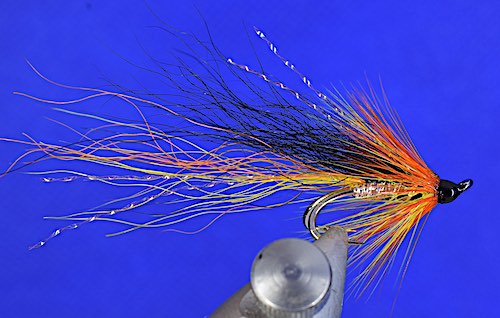
In clear water I use size 10 or smaller drab coloured fly (e.g. Stoats tail, Blue Charm, etc)
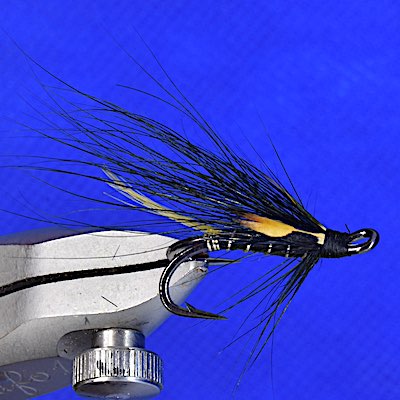
How to get to the Channel Pool:
From Llangollen take the A5 to Crown then just after the junction with the B5103 by Berwyn Station take the next right and follow the lane for about 1mile. At the lane end, you will see the top car park on your left.
Walk up the lane from the car park to the style on the right that takes you into the field. Follow the fence on the left down to the river. Turn right and the Channels is about 50 metres downriver. A map of this pool can be found on Llangollen-Maelor Angling website.
Fishing, like most outdoor sports, is not without its hazards. Therefore, YOU MUST DO YOUR OWN RISK ASSESSMENT before starting to fish the Channel Pool. Especially if you decide to wade and/or fish at night. In addition, you must follow the Llangollen-Maelor Club Rules when accessing and fishing this water.